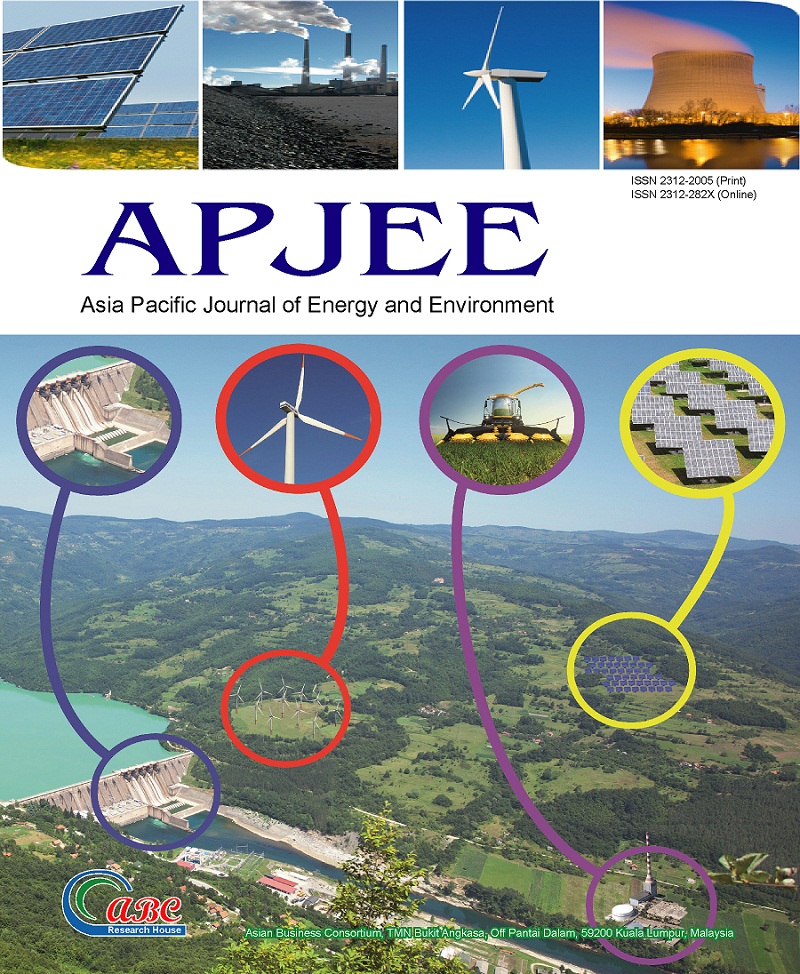The Role of Artificial Intelligence in Optimizing Rubber Manufacturing Processes
DOI:
https://doi.org/10.18034/apjee.v10i1.747Keywords:
Artificial Intelligence, Rubber Manufacturing, Optimization, Machine Learning, Predictive Analytics, Smart Manufacturing, Quality Control, Industrial AutomationAbstract
This review article examines how Artificial Intelligence (AI) can be used to optimize rubber production processes. The main goals are to list rubber manufacturers' difficulties, investigate AI applications, highlight significant discoveries, and discuss the policy ramifications for effective AI integration. Using a secondary data-based methodology, the study gathers information about AI applications unique to the rubber manufacturing business by reviewing a large body of literature from conferences, peer-reviewed journals, and industry reports. The results show that artificial intelligence (AI) technologies in rubber manufacturing facilitate improved process optimization, predictive maintenance, quality control, and adaptive process control. Artificial intelligence (AI)-powered technologies enhance compounded formulations, automate shaping procedures, forecast equipment breakdowns, and maximize resource efficiency. The policy consequences encompass resolving data privacy issues, allocating resources toward workforce training, instituting moral AI governance structures, and offering monetary incentives to encourage the deployment of AI. In summary, artificial intelligence has revolutionary prospects for rubber producers to improve productivity, excellence, and environmental friendliness. Rubber manufacturing processes can be made more innovative and continuously enhanced by embracing AI-driven solutions and strategic plans.
Metrics
Downloads
References
Ahangar-Asr, A., Faramarzi, A., Javadi, A. A., Giustolisi, O. (2011). Modelling Mechanical Behaviour of Rubber Concrete Using Evolutionary Polynomial Regression. Engineering Computations, 28(4), 492-507. https://doi.org/10.1108/02644401111131902 DOI: https://doi.org/10.1108/02644401111131902
Anumandla, S. K. R. (2018). AI-enabled Decision Support Systems and Reciprocal Symmetry: Empowering Managers for Better Business Outcomes. International Journal of Reciprocal Symmetry and Theoretical Physics, 5, 33-41. https://upright.pub/index.php/ijrstp/article/view/129
Dhameliya, N., Mullangi, K., Shajahan, M. A., Sandu, A. K., & Khair, M. A. (2020). Blockchain-Integrated HR Analytics for Improved Employee Management. ABC Journal of Advanced Research, 9(2), 127-140. https://doi.org/10.18034/abcjar.v9i2.738 DOI: https://doi.org/10.18034/abcjar.v9i2.738
Ghatarband, M., Asadi, Z. A., Mazinani, S., Kalaee, M. R., Shiri, M. E. (2015). Predicting Mechanical Properties of Elastomeric Modified Nylon Blend Using Adaptive Neuro-fuzzy Interference System and Neural Network. The International Journal of Advanced Manufacturing Technology, 76(5-8), 961-970. https://doi.org/10.1007/s00170-014-6294-5 DOI: https://doi.org/10.1007/s00170-014-6294-5
Khair, M. A., Tejani, J. G., Sandu, A. K., & Shajahan, M. A. (2020). Trade Policies and Entrepreneurial Initiatives: A Nexus for India’s Global Market Integration. American Journal of Trade and Policy, 7(3), 107–114. https://doi.org/10.18034/ajtp.v7i3.706 DOI: https://doi.org/10.18034/ajtp.v7i3.706
Koehler, S., Dhameliya, N., Patel, B., & Anumandla, S. K. R. (2018). AI-Enhanced Cryptocurrency Trading Algorithm for Optimal Investment Strategies. Asian Accounting and Auditing Advancement, 9(1), 101–114. https://4ajournal.com/article/view/91
Lu, P., Chen, S., Zheng, Y. (2012). Artificial Intelligence in Civil Engineering. Mathematical Problems in Engineering, 2012. https://doi.org/10.1155/2012/145974 DOI: https://doi.org/10.1155/2012/145974
Maddula, S. S. (2018). The Impact of AI and Reciprocal Symmetry on Organizational Culture and Leadership in the Digital Economy. Engineering International, 6(2), 201–210. https://doi.org/10.18034/ei.v6i2.703 DOI: https://doi.org/10.18034/ei.v6i2.703
Maddula, S. S., Shajahan, M. A., & Sandu, A. K. (2019). From Data to Insights: Leveraging AI and Reciprocal Symmetry for Business Intelligence. Asian Journal of Applied Science and Engineering, 8(1), 73–84. https://doi.org/10.18034/ajase.v8i1.86 DOI: https://doi.org/10.18034/ajase.v8i1.86
Mullangi, K. (2017). Enhancing Financial Performance through AI-driven Predictive Analytics and Reciprocal Symmetry. Asian Accounting and Auditing Advancement, 8(1), 57–66. https://4ajournal.com/article/view/89
Mullangi, K., Maddula, S. S., Shajahan, M. A., & Sandu, A. K. (2018a). Artificial Intelligence, Reciprocal Symmetry, and Customer Relationship Management: A Paradigm Shift in Business. Asian Business Review, 8(3), 183–190. https://doi.org/10.18034/abr.v8i3.704 DOI: https://doi.org/10.18034/abr.v8i3.704
Mullangi, K., Yarlagadda, V. K., Dhameliya, N., & Rodriguez, M. (2018b). Integrating AI and Reciprocal Symmetry in Financial Management: A Pathway to Enhanced Decision-Making. International Journal of Reciprocal Symmetry and Theoretical Physics, 5, 42-52. https://upright.pub/index.php/ijrstp/article/view/134
Patel, B., Mullangi, K., Roberts, C., Dhameliya, N., & Maddula, S. S. (2019). Blockchain-Based Auditing Platform for Transparent Financial Transactions. Asian Accounting and Auditing Advancement, 10(1), 65–80. https://4ajournal.com/article/view/92
Pydipalli, R. (2018). Network-Based Approaches in Bioinformatics and Cheminformatics: Leveraging IT for Insights. ABC Journal of Advanced Research, 7(2), 139-150. https://doi.org/10.18034/abcjar.v7i2.743 DOI: https://doi.org/10.18034/abcjar.v7i2.743
Pydipalli, R., & Tejani, J. G. (2019). A Comparative Study of Rubber Polymerization Methods: Vulcanization vs. Thermoplastic Processing. Technology & Management Review, 4, 36-48. https://upright.pub/index.php/tmr/article/view/132
Pydipalli, R., Anumandla, S. K. R., Dhameliya, N., Thompson, C. R., Patel, B., Vennapusa, S. C. R., Sandu, A. K., & Shajahan, M. A. (2022). Reciprocal Symmetry and the Unified Theory of Elementary Particles: Bridging Quantum Mechanics and Relativity. International Journal of Reciprocal Symmetry and Theoretical Physics, 9, 1-9. https://upright.pub/index.php/ijrstp/article/view/138
Richardson, N., Pydipalli, R., Maddula, S. S., Anumandla, S. K. R., & Vamsi Krishna Yarlagadda. (2019). Role-Based Access Control in SAS Programming: Enhancing Security and Authorization. International Journal of Reciprocal Symmetry and Theoretical Physics, 6, 31-42. https://upright.pub/index.php/ijrstp/article/view/133
Rodriguez, M., Shajahan, M. A., Sandu, A. K., Maddula, S. S., & Mullangi, K. (2021). Emergence of Reciprocal Symmetry in String Theory: Towards a Unified Framework of Fundamental Forces. International Journal of Reciprocal Symmetry and Theoretical Physics, 8, 33-40. https://upright.pub/index.php/ijrstp/article/view/136
Rodriguez, M., Tejani, J. G., Pydipalli, R., & Patel, B. (2018). Bioinformatics Algorithms for Molecular Docking: IT and Chemistry Synergy. Asia Pacific Journal of Energy and Environment, 5(2), 113-122. https://doi.org/10.18034/apjee.v5i2.742 DOI: https://doi.org/10.18034/apjee.v5i2.742
Sachani, D. K., & Vennapusa, S. C. R. (2017). Destination Marketing Strategies: Promoting Southeast Asia as a Premier Tourism Hub. ABC Journal of Advanced Research, 6(2), 127-138. https://doi.org/10.18034/abcjar.v6i2.746 DOI: https://doi.org/10.18034/abcjar.v6i2.746
Saeb, M. R., Rezaee, B., Shadman, A., Formela, K., Ahmadi, Z. (2017). Controlled Grafting of Vinylic Monomers on Polyolefins: A Robust Mathematical Modeling Approach. Designed Monomers and Polymers, 20(1), 268. https://doi.org/10.1080/15685551.2016.1239166 DOI: https://doi.org/10.1080/15685551.2016.1239166
Sandu, A. K. (2021). DevSecOps: Integrating Security into the DevOps Lifecycle for Enhanced Resilience. Technology & Management Review, 6, 1-19. https://upright.pub/index.php/tmr/article/view/131
Sandu, A. K. (2022). AI-Powered Predictive Maintenance for Industrial IoT Systems. Digitalization & Sustainability Review, 2(1), 1-14. https://upright.pub/index.php/dsr/article/view/139
Sandu, A. K., Pydipalli, R., Tejani, J. G., Maddula, S. S., & Rodriguez, M. (2022). Cloud-Based Genomic Data Analysis: IT-enabled Solutions for Biotechnology Advancements. Engineering International, 10(2), 103–116. https://doi.org/10.18034/ei.v10i2.712 DOI: https://doi.org/10.18034/ei.v10i2.712
Shajahan, M. A. (2018). Fault Tolerance and Reliability in AUTOSAR Stack Development: Redundancy and Error Handling Strategies. Technology & Management Review, 3, 27-45. https://upright.pub/index.php/tmr/article/view/126
Shajahan, M. A. (2021). Next-Generation Automotive Electronics: Advancements in Electric Vehicle Powertrain Control. Digitalization & Sustainability Review, 1(1), 71-88. https://upright.pub/index.php/dsr/article/view/135
Shajahan, M. A., Richardson, N., Dhameliya, N., Patel, B., Anumandla, S. K. R., & Yarlagadda, V. K. (2019). AUTOSAR Classic vs. AUTOSAR Adaptive: A Comparative Analysis in Stack Development. Engineering International, 7(2), 161–178. https://doi.org/10.18034/ei.v7i2.711 DOI: https://doi.org/10.18034/ei.v7i2.711
Tejani, J. G. (2017). Thermoplastic Elastomers: Emerging Trends and Applications in Rubber Manufacturing. Global Disclosure of Economics and Business, 6(2), 133-144. https://doi.org/10.18034/gdeb.v6i2.737 DOI: https://doi.org/10.18034/gdeb.v6i2.737
Tejani, J. G., Khair, M. A., & Koehler, S. (2021). Emerging Trends in Rubber Additives for Enhanced Performance and Sustainability. Digitalization & Sustainability Review, 1(1), 57-70. https://upright.pub/index.php/dsr/article/view/130
Vennapusa, S. C. R., Fadziso, T., Sachani, D. K., Yarlagadda, V. K., & Anumandla, S. K. R. (2018). Cryptocurrency-Based Loyalty Programs for Enhanced Customer Engagement. Technology & Management Review, 3, 46-62. https://upright.pub/index.php/tmr/article/view/137
Yarlagadda, V. K., & Pydipalli, R. (2018). Secure Programming with SAS: Mitigating Risks and Protecting Data Integrity. Engineering International, 6(2), 211–222. https://doi.org/10.18034/ei.v6i2.709 DOI: https://doi.org/10.18034/ei.v6i2.709
Ying, D., Patel, B., & Dhameliya, N. (2017). Managing Digital Transformation: The Role of Artificial Intelligence and Reciprocal Symmetry in Business. ABC Research Alert, 5(3), 67–77. https://doi.org/10.18034/ra.v5i3.659 DOI: https://doi.org/10.18034/ra.v5i3.659
Yousef, B. F., Mourad, A-H. I., Hilal-Alnaqbi, A. (2013). Modeling of the Mechanical Behavior of Polyethylene/polypropylene Blends using Artificial Neural Networks. The International Journal of Advanced Manufacturing Technology, 64(5-8), 601-611. https://doi.org/10.1007/s00170-012-4069-4 DOI: https://doi.org/10.1007/s00170-012-4069-4
Zhang, J., Tang, W. (2013). Rubber Curing Process Simulation Based on Parabola Model. Journal of Wuhan University of Technology. Materials Science Edition, 28(1), 150-156. https://doi.org/10.1007/s11595-013-0657-x DOI: https://doi.org/10.1007/s11595-013-0657-x
Zuo, S. L. (2012). Combining a Radial Basis Function Neural Network with Improved Genetical Gorithm for Vulcanizing Process Parameter Optimization. Applied Mechanics and Materials, 246-247, 433. https://doi.org/10.4028/www.scientific.net/AMM.246-247.433 DOI: https://doi.org/10.4028/www.scientific.net/AMM.246-247.433
Downloads
Published
Issue
Section
License
Copyright (c) 2023 Arun Kumar Sandu

This work is licensed under a Creative Commons Attribution-NonCommercial 4.0 International License.





